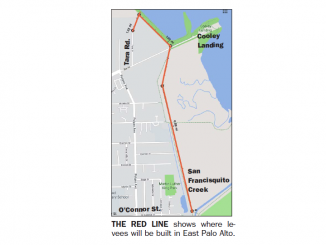
BY ALLISON LEVITSKY
Daily Post Staff Writer
A long-awaited environmental report recommends a new Pope-Chaucer Bridge to prevent another catastrophic flood like the one that hit Palo Alto, East Palo Alto and Menlo Park in 1998, forcing the evacuations of 500 people and causing more than $28 million in damage.
The 885-page draft environmental impact report on flood protection and ecosystem restoration upstream of Highway 101 was released on April 22 by the San Francisquito Creek Joint Powers Authority, the government agency that formed in response to the 1998 flood.
In that flood, the Pope-Chaucer Bridge was blamed for much of the damage after it became clogged with debris and vegetation. With the new report, creek officials recommend rebuilding the Pope-Chaucer Bridge with a structure with greater flow capacity.
They also recommend widening the creek and building detention basins at Searsville Dam, Webb Ranch and the former Boething plant nursery at Stanford.
Creek walls
Some new concrete would be added to the walls of the creek, but more would be taken out to restore natural habitat, creek agency Senior Project Manager Kevin Murray told the Post.
The proposed projects would increase the creek flow to at least 7,500 cubic feet per second, or cfs, enough to accommodate the peak flow recorded during the 1998 flood.
A 100-year flood, or a flood that has a 1% chance of happening in any given year, would be expected to result in a flow of 8,150 cfs at the Pope-Chaucer Bridge.
That’s because the Middlefield Road bridge constricts the creek. But rather than replace the Middlefield bridge, creek officials want to see new storm water detention basins at Stanford.
Water detention on Stanford lands
Stanford is currently looking at modifying the clogged Searsville Dam and reservoir by creating an opening at the base of the dam and using creek flows to send sediment downstream.
That would create a new channel upstream of a new dam opening, allowing fish to pass through and accommodating an additional 800 to 1,000 cfs, according to creek officials.
Creek board Chair Gary Kremen, who represents Palo Alto, Mountain View and Los Altos on the board of the Santa Clara Valley Water District, said that the creek agency may seize Stanford land through eminent domain if the university doesn’t cooperate with the project and provide a place to retain water.
“We’re not hesitant to do what’s the best economical solution for the majority of people,” Kremen told the Post. “I ain’t scared of no Stanford.”
The project is expected to cost between $70 and $90 million, Kremen said, but the cost and funding sources aren’t addressed in the environmental report.
Kremen said some of the funding would come from the tax dollars of his constituents in Palo Alto and parts of Mountain View and Los Altos Hills, who pay taxes to the Santa Clara Valley Water District but get their water elsewhere.
Murray said other funds would likely come from the state and federal governments and Measure B in Santa Clara County.
A new tax wouldn’t be likely, Murray said.
Other government agencies, private entities like Stanford and the public will have until June 19 to comment in writing on the draft environmental impact report.
Public hearings are planned at the Laurel School Upper Campus in Menlo Park on May 23, at East Palo Alto City Hall on May 29 and at the Palo Alto Art Center on June 5.
Here’s a link for more on the San Francisquito Creek JPA’s proposals.



